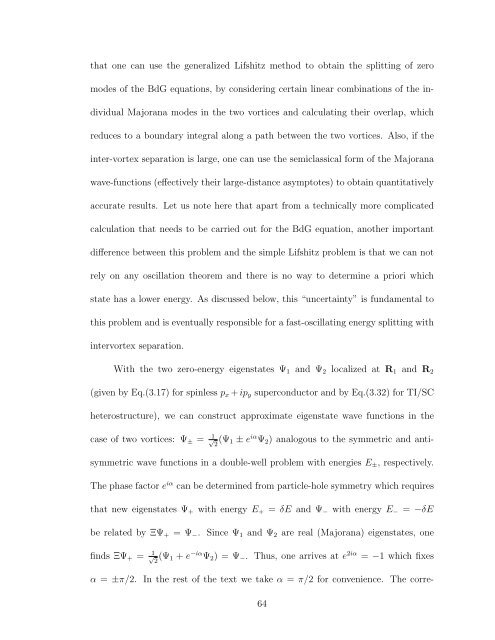ABSTRACT - DRUM - University of Maryland
ABSTRACT - DRUM - University of Maryland
ABSTRACT - DRUM - University of Maryland
You also want an ePaper? Increase the reach of your titles
YUMPU automatically turns print PDFs into web optimized ePapers that Google loves.
that one can use the generalized Lifshitz method to obtain the splitting <strong>of</strong> zero<br />
modes <strong>of</strong> the BdG equations, by considering certain linear combinations <strong>of</strong> the individual<br />
Majorana modes in the two vortices and calculating their overlap, which<br />
reduces to a boundary integral along a path between the two vortices. Also, if the<br />
inter-vortex separation is large, one can use the semiclassical form <strong>of</strong> the Majorana<br />
wave-functions (effectively their large-distance asymptotes) to obtain quantitatively<br />
accurate results. Let us note here that apart from a technically more complicated<br />
calculation that needs to be carried out for the BdG equation, another important<br />
difference between this problem and the simple Lifshitz problem is that we can not<br />
rely on any oscillation theorem and there is no way to determine a priori which<br />
state has a lower energy. As discussed below, this “uncertainty” is fundamental to<br />
this problem and is eventually responsible for a fast-oscillating energy splitting with<br />
intervortex separation.<br />
With the two zero-energy eigenstates Ψ 1 and Ψ 2 localized at R 1 and R 2<br />
(given by Eq.(3.17) for spinless p x + ip y superconductor and by Eq.(3.32) for TI/SC<br />
heterostructure), we can construct approximate eigenstate wave functions in the<br />
case <strong>of</strong> two vortices: Ψ ± = 1 √<br />
2<br />
(Ψ 1 ± e iα Ψ 2 ) analogous to the symmetric and antisymmetric<br />
wave functions in a double-well problem with energies E ± , respectively.<br />
The phase factor e iα can be determined from particle-hole symmetry which requires<br />
that new eigenstates Ψ + with energy E + = δE and Ψ − with energy E − = −δE<br />
be related by ΞΨ + = Ψ − . Since Ψ 1 and Ψ 2 are real (Majorana) eigenstates, one<br />
finds ΞΨ + = 1 √<br />
2<br />
(Ψ 1 + e −iα Ψ 2 ) = Ψ − . Thus, one arrives at e 2iα = −1 which fixes<br />
α = ±π/2. In the rest <strong>of</strong> the text we take α = π/2 for convenience. The corre-<br />
64
















